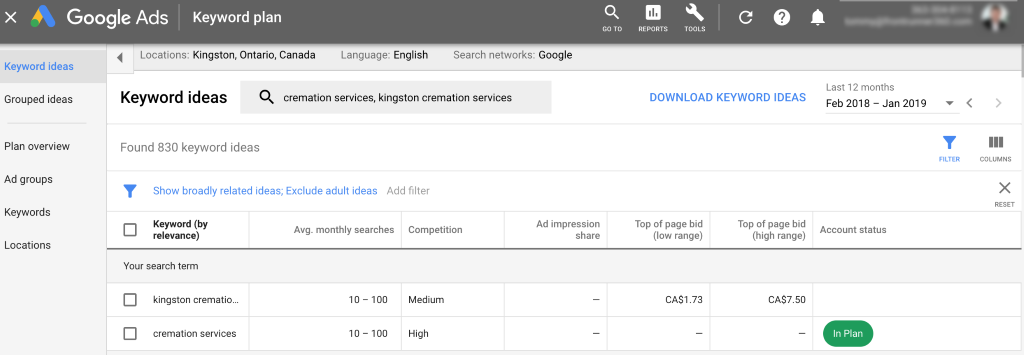8 Tips To Improve Funeral Home SEO In 2019

Optimizing your funeral home’s website for search engines can be difficult if you’re unsure where to start. With Google and others continually updating their algorithms, now more than ever is it imperative to be up to date with the latest SEO best practices. As search engines continue to evolve, you need to prioritize keeping your website’s content fresh and optimized to rank.
Search engine optimization for funeral homes is not just important, it’s necessary. Don’t believe me? Then consider the following. According to a recent report, 88% of consumers begin their research onlinebefore purchasing a product or service. Something else to consider is that Google shows different results depending on your location. This means that nearly 9 out of every 10 families in need in your community are looking online for funeral homes near them.
That’s why it’s so important to focus on your funeral home’s search engine optimation efforts. It’s never been easier for consumers to not only conduct research but also be able to compare all of the funeral homes in your area. If you aren’t actively working to make sure your firm ranks near the top of page one, your just losing out on potential business. Research has shown that websites on page one of Google receive nearly 95% of website traffic.
So what can you do to make sure families can easily find you online? Check out these helpful search engine optimization tips for funeral homes.
1. Understand What Exactly SEO Is
Before you start searching for keywords or trying to build backlinks to your website, take some time to understand what exactly SEO is. Why do you use Google or other search engines? Likely because you’re trying to find specific information or a website. Google looks at what you’ve searched and tries to show you the sites it thinks best answer your questions or offers the information you seek. Mostly, it’s trying to help you.
Now think about the families you serve. Does the content offered on your website help them? Try to do a few quick searches on Google for the common questions or keywords they might use if they’re trying to find a funeral home or type of service. Who is showing up in these top spots? Look at the content on their website now. What keywords or phrases are they using in the titles and content?
Google’s job is to try and present users with the information they are seeking. Search engine optimization is the combination of strategies and techniques to increase the visits to your website by improving your placement on search engine results pages (SERPs).
2. Start Speaking Your Customer’s Language
Put yourself in the shoes of a family you serve. What questions are they asking? How are they asking them? What do they need? Now, look at your website. Does the content answer these questions clearly? If you want to improve your website’s rankings, you need to understand what your prospects are searching for. A quick tip to look at popular search terms is to go to Google and start typing in a keyword like “celebration of life”. Then, let Google’s autocomplete suggestions populate. This is an excellent place to start and see some of the popular searches involving that keyword.

Once you have a basic idea of popular keywords, you can get more advanced. Use SEO tools like Moz, SEMrush, or Google’s Keyword Planner to help find relevant keywords being searched in your area. With these tools, you’ll get to see how frequently keywords are being searched, suggested alternatives, and how competitive it is to rank for specific keywords.

3. Make Your Content Useful
Content is more than just the text on a page. It includes videos, photos, downloadable resources, and so much more. The material on your site should do a good job of answering your families’ questions, understanding their obstacles, and providing helpful solutions.
Before you start creating a piece of content, make sure you know the purpose behind it. What are you trying to achieve? What information or messages does it need to communicate clearly? And most importantly, why should your audience care?
Content is a powerful tool to delight potential customers. It’s important to make sure that your content is giving visitors to your website exactly what they are seeking. Don’t just stick to creating written content. By 2020, nearly 80% of content on the internet will be video. In fact, many experts have stated that video will continue to be a top content format for years to come.
4. Tune Up Your Website
Every so often, you need to change the oil in your car, top up your fluids, check tire pressure and perform other general maintenance. The same goes for your website. Make sure to take a look under the hood and tune up your website.
This includes reviewing and updating page titles, URLs, image tags (also called alt tags) and meta descriptions. You want to make sure that your page titles accurately describe the content of your page. Your meta description should encourage people to click, and your image tags and page titles should include relevant keywords if possible.
5. Create Quality Backlinks
Backlinks are links to your website from other websites. These are very important as Google values links from sites they trust. However, if you’re receiving links from websites that Google doesn’t trust, your ranking on SERPs can be negatively affected.
If you want to check out what backlinks your site currently has, try using the SEMrush Backlink Checker or Moz Open Site Explorer. You should also make sure to look at your competitors’ websites as well. See what other sources are backlinking to them and if possible, get a backlink for your site as well.
6. Get Your Website Listed
Getting your website listed on local, national, or niche directory websites can make it easier for Google and prospects to find you. Not only does this create more exposure for your funeral home, but it also creates more backlinks for your website.
As I said at the beginning of this post, Google shows different results depending on your location. This is why it is so crucial for Google (and users) to be able to quickly detect your location. One such way to do this is by making sure you have a Google My Business listing.

Don’t just stick to providing minimal information though. Use your Google My Business listing to show hours of operation, contact information, photos from your business, and more. Customers can also leave reviews which you can respond to or ask questions about your funeral home. You also have the option of posting updates and announcements. There are currently 4 different post types: What’s New, Events, Product, and Offer.
7. Make Sure Your Website Is Fast and Secure
Because Google’s primary goal is to help users find what they’re searching for, it wants to make sure users have a safe and positive experience. Both your website’s page speed and security can affect your ranking on SERPs.
To help protect users’ security, Google wants everything to transfer over a secure channel (https). If your website does not have an SSL certificate, Google will flag the site as not secure and let users now the website is not safe. Having your funeral home’s website display, this information to users can cause your website traffic decrease.
Another way to hurt your web traffic is by having pages that take forever to load. If your website fails to load in under 3 seconds, you could be losing traffic. There’s nothing more frustrating when trying to browse the internet than a page that loads slowly. If you’re like me (and most consumers), a slow loading website results in a quick visit back to Google and visiting another website. Thankfully, funeral home websites built through the Pulse Websystemare the fastest and best performing in the industry.
8. Continuously Monitor and Update
Now that you’ve spent some time doing research and optimizing your website, it’s time to track the progress. If you aren’t currently using Google Analytics to monitor traffic to your site, make sure to sign up asap! Google Analytics helps you find insights to better understand your customers and analyze data.
When you are tracking your website’s performance, there are many different metrics to get hung up on. Below are a few of the most important ones to focus on.
Keyword Rankings
The algorithms used by search engines are always changing. Make sure to continuously monitor how your website is ranking for specific keywords. Your rankings may climb or fall from time to time based on updates and what your competitors are doing on their sites. By making sure to monitor these results, you can make adjustments to your content as needed.
Page Visits
Another key metric to track is page visits. By looking at what pages receive the most traffic, you can find insights into the type of content bringing people to your website. This can be helpful when coming up with topics for blogs or understanding what types of content your customers respond to best.
Time-on-Page
It’s nice to have people visiting your website. However, if they aren’t staying for very long, what’s the point? Time-on-page helps you understand how long someone is engaging on your site. If the average time-on-page for a certain page is only a few seconds, that tells you that you that the content on the page is not helpful to the user and should be updated.
At the same time, you also need to look at the purpose of a page. For instance, the contact us page might have low time-on-page because people are just going there to find something quickly like an address or phone number. In this case, low time-on-page isn’t really a bad thing.
Bounce Rate
Last but not least, do your best to keep your bounce rate low. Bounce rate is a percentage of visits in which the users land on your website and then leaves without browsing any further. In Google Analytics, you can track the bounce rate for your entire site and individual pages.
*Bonus Tip – Subscribe To The Pulse For More Great Advice
At FrontRunner, we’ve always made it a priority to help our clients grow and achieve more. This year, we want to take things even further and offer an educational resource directly to your inbox.
The Pulse is our new educational newsletter for funeral professionals. When you subscribe to The Pulse, you can expect to receive an email each month filled content to help you grow and better manage your business.
If you want to subscribe to this free and helpful resource, click below!
Tommy holds a Communications degree from Laurentian University and an Integrated Marketing Communications Graduate Certificate from St. Lawrence College. He is a Content Marketing Specialist at FrontRunner and focuses on producing engaging content that funeral homes can use to connect with families. In addition, Tommy crafts SEO content for clients and specializes in helping the general public connect with the death care industry as a whole.

